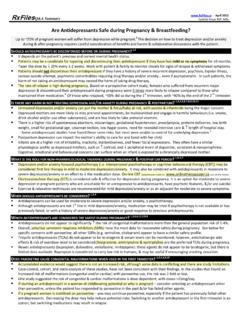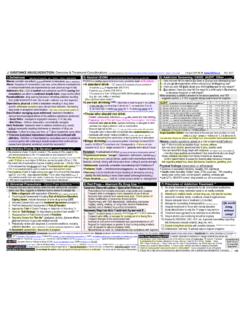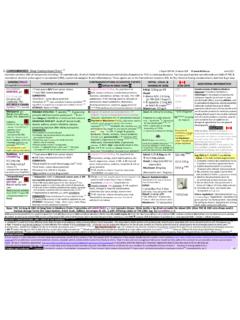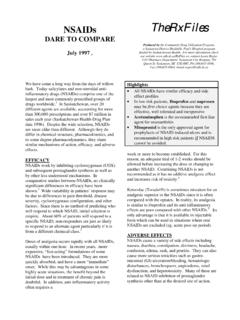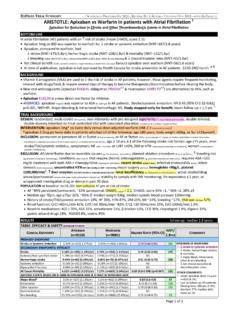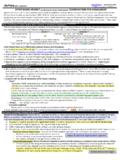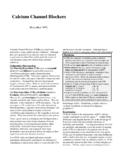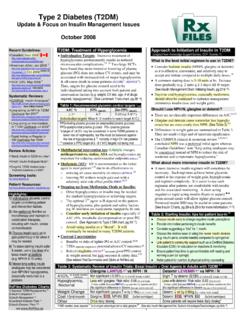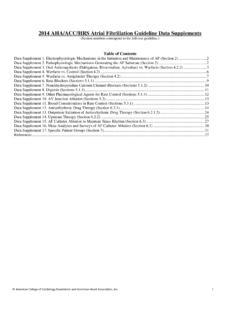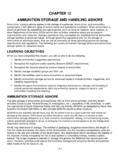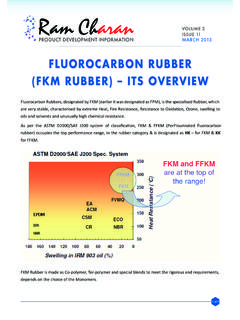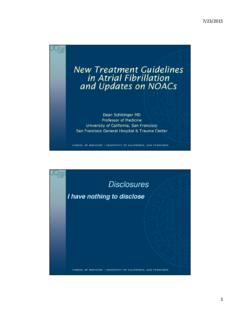Transcription of RXFILES TRIAL SUMMARY O PREPARED IN EVISED BY L KOSAR ...
1 RXFILES TRIAL SUMMARY ORIGINALLY PREPARED BY: M JIN, REVISED BY: L KOSAR UPDATED DECEMBER 2012 Page 1 of 4 rocket AF: Rivaroxaban vs Warfarin in patients with atrial fibrillation 1 Rivaroxaban Once daily oral direct factor Xa inhibition Compared with vitamin K antagonism for prevention of stroke and Embolism TRIAL in AF BOTTOM LINE In atrial fibrillation (AF) patients with an risk of stroke (mean CHADS2 score ), rivaroxaban 20mg po daily: Was non inferior ( no worse than) to warfarin for stroke or systemic embolism Had less hemorrhagic strokes, systemic embolism & bleeding (critical, fatal & intracranial) versus warfarin Had more drops in hemoglobin 20 g/L, tranfusions, gastrointestinal bleeding, epistaxis & hematuria versus warfarin At time of publication, rivaroxaban for AF is approximately $100/month; 15mg, 20mg tablets. A Fib, Warfarin + monitoring ~$35/month. BACKGROUND Vitamin K antagonists (VKA) are used to the risk of stroke in AF patients; however, these agents require frequent monitoring, interact with drugs/food, & require several days of therapy to become therapeutic/discontinuation before clearing the body.
2 New oral anticoagulants (apixaban ELIQUIS,2,3 dabigatran PRADAX 4,5 & rivaroxaban XARELTO) are alternatives to VKA, such as warfarin. Rivaroxaban XARELTO is a new oral direct factor Xa inhibitor. rocket AF is the first Phase III study assessing the use of rivaroxaban for stroke prevention in AF patients. TRIAL BACKGROUND 6 DESIGN: randomized, multi centre 45 countries, double blinded, double dummy controlled TRIAL with concealed allocation; non inferiority with pre designed superiority, intention to treat & per protocol analysis. Funded by Johnson & Johnson and Bayer. INTERVENTION: rivaroxaban 20mg* po daily vs dose adjusted warfarin (INR 2 3 measured 1 month) * rivaroxaban 15mg po daily in patients with CrCl 30 49 mL/min see page 2 for subgroup analysis INCLUSION: persistent/paroxysmal AF on 2 episodes 1 documented on ECG within 30 days of enrolment; age 18 yrs; risk of future stroke: history of stroke/TIA or systemic embolism OR 2 of the following: HF or LVEF 35%, HTN (on BP meds 6 months before or SBP>140 mmHg or DBP >90 mmHg), age 75 yr, or DM ( CHADS2 score of 2).
3 Only 10% could have a CHADS2 score of 2, with the remainder having a score of 3 or prior stroke, TIA or systemic embolism. EXCLUSION: Cardiac related conditions AF due to reversible disorders, active endocarditis, mitral stenosis, presence of atrial myxoma or LV thrombus, planned cardioversion, prosthetic heart valve, BP 180/100 mmHg; Hemorrhage risk related criteria active internal bleeding, hx of major surgical procedure or trauma within 30 days, GI bleed within 6 months, hx of intracranial/intraocular/spinal/atraumat ic intraarticular bleeding, chronic hemorrhagic disorder, known intracranial neoplasm, arteriovenous malformation, or aneurysm, planned invasive procedure with potential for uncontrolled bleeding, including major surgery; anemia Hgb <100g/L; any stroke within 14 days (severe within 90 days) or TIA within 3 days; indication for anticoagulant therapy for a condition other than AF ( VTE); tx with ASA>100mg/d, ASA/thienopyridine or IV antiplatelets within 5 days; fibrinolytics within 10 days; anticipated need for long term tx with NSAID.
4 Systemic treatment with a strong inhibitor/inducer of CYP P450 3A4 within 4 days or planned treatment during the study; pregnancy/breastfeeding; HIV; CrCl<30mL/min; liver disease or ALT>3x ULN. POPULATION at baseline: n=14,264 non valvular AF patients at risk of stroke AF ~81% persistent, ~ paroxysmal, newly diagnosed/onset; CHADS2 mean = , median=3, CHADS2 score ~13% =2, 43% =3, 29% =4, 13% =5, rivaroxaban vs warfarin = 6 (p< for CHADS2 score of 6). ~60% ; median age 73yrs 25% 78yrs, BMI 28 kg/m2, BP 130/80 mmHg, CrCl 67mL/min History of stroke/TIA 55%, HF 63%, HTN 91%, DM 40%, MI 17% Baseline medications: blocker ~65%, diuretics 60%, ACE I 55%, statins 43%, digoxin 39%, ASA 38%. Previous use of vitamin K antagonist 62%. RESULTS median follow up: per protocol (PP) & safety population = 590 days, intention to treat (ITT) = 707 days TABLE: EFFICACY & SAFETY NON INFERIOR DATA SUPERIORITY DATA RIVAROXABAN WARFARIN HAZARD RATIO (95% CI) NNT/NNH PRIMARY ENDPOINTS PER PROTOCOL (n=6958) ITT (n=7081) PER PROTOCOL(n=7004) ITT (n=7090) PER PROTOCOL ITT PP/ ITT/ Comments Stroke or Systemic Embolism {n=188} {n=269} {n=241} {n=306} ( ) ( ) 135 SECONDARY ENDPOINTS RIVAROXABAN (n=7061) WARFARIN (n=7082) HAZARD RATIO (95% CI) NNT/NNH EFFICACY: Based on safety population, rivaroxaban n=7061 vs warfarin n=7082 excluded violating site & those who did not receive a dose Stroke {n=184} ( ) {n=221} ( ) NS Hemorrhagic Stroke {n=29} ( ) {n=50} ( ) ( ) 333 Systemic Embolism {n=5} ( ) {n=22} ( ) ( ) 417 Myocardial Infarction {n=101} ( ) {n=126} ( ) NS All Cause Mortality {n=208} ( ) {n=250} ( ) NS BLEEDING.
5 Based on safety population, rivaroxaban n=7111 vs warfarin n=7082 excluded those who did not receive a dose Major Bleed* {n=395} ( ) {n=386} ( ) NS Hemoglobin 20g/L {n=305} ( ) {n=254} ( ) ( ) 143 Transfusion {n=183} ( ) {n=149} ( ) ( ) 200 Critical Bleeding {n=91} ( ) {n=133} ( ) ( ) 167 Fatal Bleeding {n=27} ( ) {n=55} ( ) ( ) 250 Intracranial bleed {n=55} ( ) {n=84} ( ) ( ) 250 Gastrointestinal Bleed {n=224} {n=154} P< 100 Epistaxis {n=721} {n=609} P< 67 Hematuria {n=296} {n=242} P< 125 Discontinuation Rates RIVAROXABAN VS WARFARIN: - Non inferior ( no worse than) to warfarin for stroke or systemic embolism. - hemorrhagic stroke, systemic embolism & bleeding (critical, fatal & intracranial). - drop of hemoglobin 20g/L, transfusion, GI bleed, epistaxis & hematuria. WARFARIN VS RIVAROXABAN: - concurrent ASA use: warfarin ( ) vs rivaroxaban ( ) - baseline CHADS2 score of 6: warfarin ( ) vs rivaroxaban ( ), p< - Warfarin TTR= mean 55%, median 58%.
6 North American sites: 64%.7 OTHER COMMENTS: - Lost to follow up: 32 - 93 patients excluded (50 rivaroxaban & 43 warfarin) from all efficacy analyses before unblinding because of violations in Good Clinical Practice. - Subgroup analyses: NS * Major Bleed = Hemoglobin 20g/L, transfused 2units, or symptomatic bleeding critical area or organ (intracranial, spinal, ocular, pericardial, articular, retroperitoneal, or intramuscular with compartment syndrome), fatal outcome or permanent disability. Gastrointes nal Bleed = upper, lower, rectal gastrointestinal bleeding RXFILES TRIAL SUMMARY ORIGINALLY PREPARED BY: M JIN, REVISED BY: L KOSAR UPDATED DECEMBER 2012 Page 2 of 4 PUBLISHED SUBGROUP ANALYSES Note: subgroup analyses are not powered to detect a conclusive difference between treatments groups; however, the following subgroup analyses were similar to the overall TRIAL results with the entire patient population. 1) Pre Designed Subgroup Analysis of rocket AF Patients with Moderate Renal Impairment (=CrCl 30 49 mL/min at baseline)8 Background: patients with CrCl 30 49 mL/min have a 25 30% rivaroxaban serum concentration 25% in rivaroxaban =15mg N=2950 ( of rocket AF patient population), rivaroxaban 15mg po daily (n=1474) vs dose adjusted warfarin (INR 2 3, n=1476) Population: compared to the rocket AF patients with CrCl 50 mL/min, patients with a CrCl 30 49 mL/min: - age (median 79 years), CHADS2 score (mean 1), history of HF ~66%, PAD ~ & MI ~19% - 45%, BMI (median 25 kg/m2), history of stroke/TIA ~50% & DM ~32% Compared to the rocket AF patients with CrCl 50 mL/min, patients with a CrCl 30 49 mL/min had an risk of stroke & systemic embolism (primary endpoint) & risk of bleeding.
7 Rivaroxaban 15mg po daily vs warfarin had consistent results when compared to patients with preserved renal function. 2) Pre Designed Subgroup Analysis of rocket AF Patients with Previous Stroke or TIA9 N=7468 (52% of rocket AF patient population), previous stroke (n=4907) or TIA (n=2561) Median time from previous stroke or TIA to randomization was 551 days (interquartile range 126 1702 days) Rivaroxaban (n=3754) versus warfarin (n=3714) Population: compared to rocket AF patients without a history of stroke/TIA, patients with a history of stroke/TIA (p< ): - CrCl (median 69 mL/min), CHADS2 score (median 4), previous ASA (38%) or vitamin K antagonist (59%) use - age (median 71 years), BMI (median kg/m2), persistent AF (80%), HTN 85%, HF 51%, DM 25%, MI 15%, PAD 5%, COPD 9% Regardless of study group, patients with a history of stroke/TIA had risk of stroke & systemic embolism (primary endpoint) & risk of major bleeding (compared to rocket AF patients without a history of stroke/TIA): - Stroke & systemic embolism.
8 Without history of stroke/TIA vs with a history of stroke/TIA , HR (95% CI ), p< - Major bleeding: without history of stroke/TIA versus with a history of stroke/TIA , HR (95% CI ), p= The comparison of rivaroxaban versus warfarin was similar, regardless of whether the anticoagulants were used as primary or secondary stroke prevention. STRENGTHS, LIMITATIONS, & UNCERTAINTIES STRENGTHS: Important clinical endpoints ( stroke & bleed) Double blind, double dummy with sham INRs Moderate to high risk of stroke (mean CHADS2 score = ) Used both per protocol & intention to treat analysis Similar discontinuation rates in both groups (rivaroxaban versus warfarin ) Only 32 patients lost to follow up ( ) LIMITATIONS: Warfarin was within therapeutic range only 55% North American sites 64% of the study period ACTIVE W , ARISTOTLE 66%, RELY 64% Short study duration One site violated Good Clinical Practice ~ 35% of patients in each arm of the TRIAL were on concomitant aspirin treatment UNCERTAINITIES: Drug not yet studied in patients with CrCL<30 mL/min or in liver disease Drug interactions?
9 Stroke after rivaroxaban stopped 28 days later No antidote for reversing bleeding with rivaroxaban Lack long term follow up & real world experience with rivaroxaban RELATED STUDIES J rocket AF10 Japan was not included in the original rocket AF TRIAL because: - Pharmacokinetic data: Cmax & area under the curve for rivaroxaban 15mg po daily in Japanese patients rivaroxaban 20mg po daily in Caucasians. - Japanese clinical practice guidelines recommend a target INR of in patients 70 years of age. N=1280; randomized, double blind, double dummy, multicentre 167 sites non inferiority TRIAL in Japan. Intervention: rivaroxaban 15mg* po daily versus dose adjusted warfarin (INR 2 3 in patients <70 years of age & INR in patients 70 years old). *rivaroxaban 10mg po daily in patients with CrCl 30 49 mL/min 22% of the patient population Safety: rivaroxaban was non inferior to warfarin for the composite of major & non major bleeding; individual composite endpoints not statistically significant when separated.
10 Differences in location of bleeds were not tested for statistical significance. Efficacy: not powered for efficacy stroke & systemic embolism was NS (p= ). Overall, the J rocket AF study results were similar to the global rocket AF study. RXFILES RELATED LINKS atrial fibrillation Treatment Overview atrial Oral Antiplatelet & Antithrombotic Agents Comparison Chart Canadian Family Physician RXFILES : Article Oral anticoagulation in atrial fibrillation ARISTOTLE (apixaban ELIQUIS vs warfarin in AF) TRIAL SUMMARY AF RELY (dabigatran PRADAX vs warfarin in AF) TRIAL SUMMARY LY TRIAL ACTIVE A (ASA clopidogrel PLAVIX in AF) & ACTIVE W (ASA + clopidogrel PLAVIX vs warfarin in AF) TRIAL SUMMARY A TRIAL RACE II (lenient vs strict rate control in AF) TRIAL SUMMARY II PALLAS (dronedarone MULTAQ in permanent AF) TRIAL SUMMARY TRIAL % RXFILES TRIAL SUMMARY ORIGINALLY PREPARED BY: M JIN, REVISED BY: L KOSAR UPDATED DECEMBER 2012 Page 3 of 4 =male = requires EDS in SK = not covered by NIHB ACE I=angiotensin converting enzyme inhibitor AF= atrial fibrillation ALT=alanine aminotransferase ASA=acetylsalicylic acid blocker=beta blocker BMI=body mass index BP=blood pressure CI=confidence interval COPD=chronic obstructive pulmonary disease CrCl=creatinine clearance CYP=cytrochrome DBP=diastolic blood pressure DM=diabetes EDS=exceptional drug status ECG=electrocardiogram GI=gastrointestinal HF=heart failure Hgb=hemoglobin HIV=human immunodeficiency virus HR=hazard ratio HTN=hypertension hx=history INR=international normalized ratio ITT=intention to treat IV=intravenous LV=left ventricle LVEF=left ventricular ejection fraction MI=myocardial infarction NNT=number needed to treat NNH=number needed to harm NS=not significant NSAID=nonsteroidal anti inflammatory drug PAD=peripheral artery disease PP=per protocol SBP=systolic blood pressure TIA=transient ischemic attack
